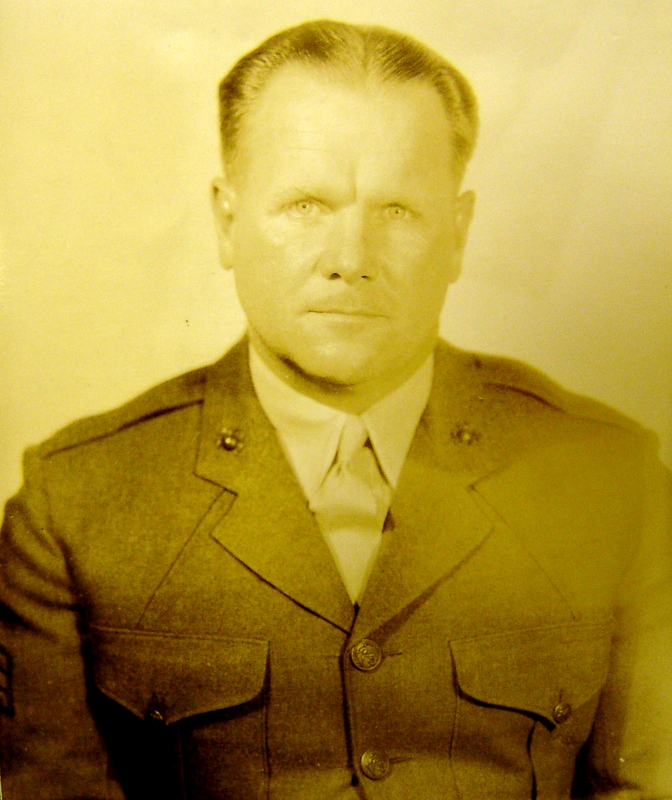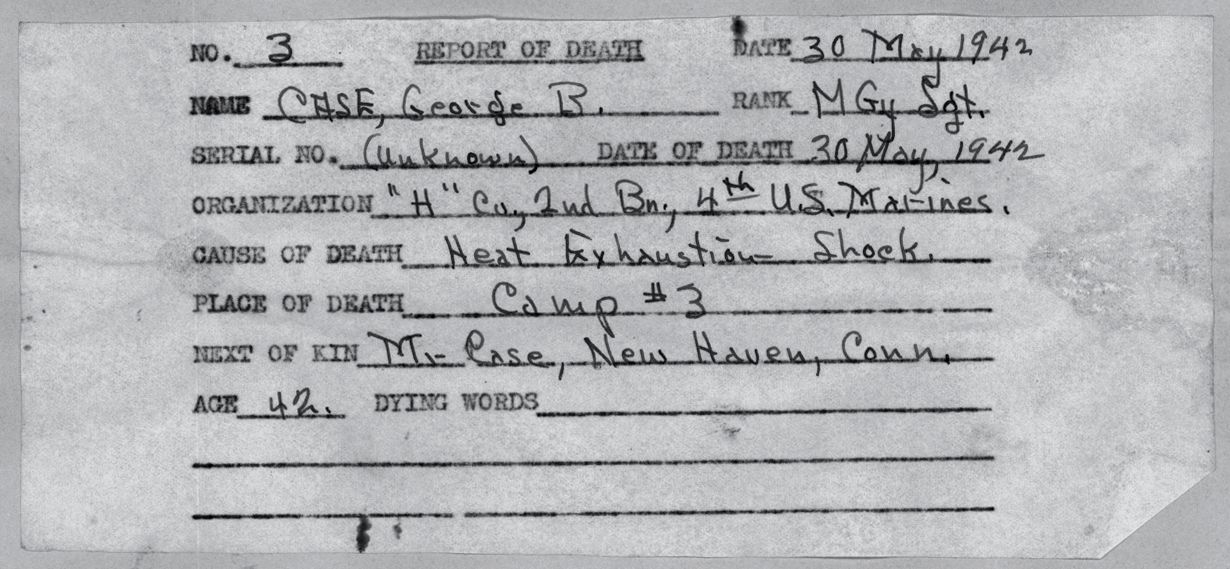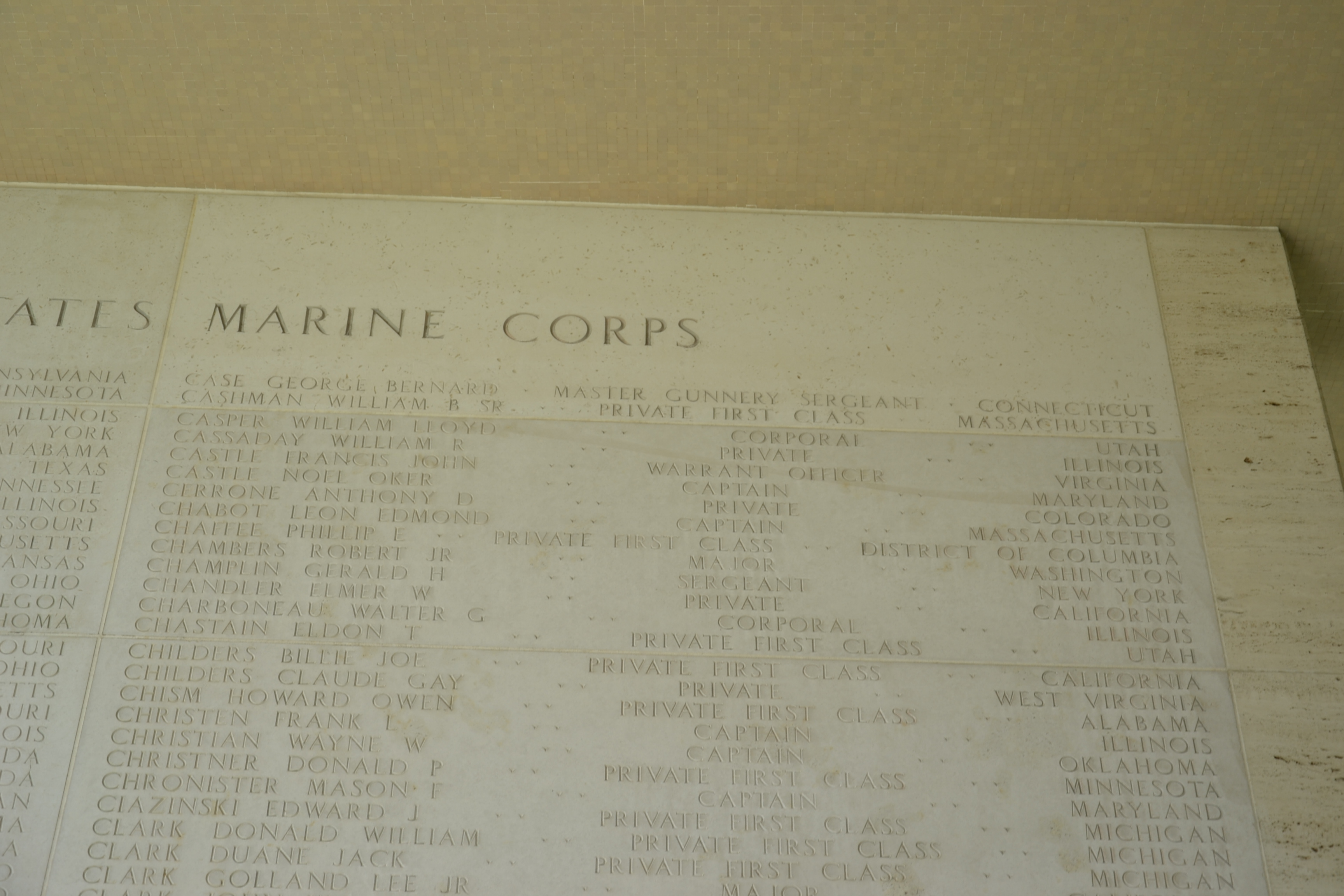Case enlisted in New York City in the United States Marine Corps, and attended his recruit boot camp training at Parris Island, South Carolina. He reported his civilian occupation as "metal polisher". His records show he was 5'6" tall and weighed abt 175 with light brown hair and blue eyes. He attended boot camp from 1//18/1918 to 4/3/1918. World War I was going on during this time and Case was assigned to the 47th Company, 3rd Battalion, 5th Marine Regiment, 2nd Army Infantry Division. Case was soon in the heat of battle at St. Mihiel (9/12-9/16/1918), the Battle at Aisne, specifically the last days of the Battle of Belleau Wood (6/21-6/26/1918) and Meuse-Argonne Offensive (10/1 - 10/11/1918). During the war, Case was shot in the left hand on 6/25/18, and then in the right hand on 10/4/1918. After the war was over, Case remained in Germany on Occupation duty at Rossbach.
Case had a storied career with service in many climates and locales to include patrolling the Yangtze River in China, Dominican Republic, France, Germany and numerous stateside duty stations. In 1941, he was promoted to the rank of Master Gunnery Sergeant. He was with the 4th Marine Regiment in the Philippines when the Imperial Japanese military forces attacked the country.
An excerpt from the book by former POW Sergeant Major Charles R. Jackson, USMC (Retired) (Deceased) describes the last days of Master Guns Case after the Allied forces surrendered at Corregidor:
" (I)n the same squad with me marched Master Gunnery Sergeant George B. Case, a veteran of World War I and the 2nd Division of those days (the Marine Battalion in World War I was attached to the Army 2nd Division), a companion in the same battalion of the 4th Marines in Bataan and Corregidor. He had come through unwounded but with a severe case of unchecked malaria. I could see that the heat was beginning to affect old George. He was often urged to fall out; others had done so and no one had been shot (many POW's were summarily executed during the Bataan Death March for falling to the wayside due to wounds, exhaustion or illness while others were simply loaded onto a truck)...he refused to take a chance, and on his arrival in camp he went out of his head. A Japanese officer thought Case's clutching grasp to support himself on "Old Pick", Marine Quarter Master Sergeant Pickering (Ray Wood Pickering), was an attempt to start a fight, and he ordered his guards to use their rifle butts and slug him down. It might have not hurt a healthy man very badly, but for Master Gunnery Sergeant George B. Case it was fatal."
Sgt Maj Jackson goes on to say that when they buried him, QMSgt Pickering "gave him (Case) his blanket, with the letters USMC on it, for a burial shroud...the act of a true Marine". This death and subsequent burial was at Camp #3 a Cabanatuan and the cemetery map shows he was buried in grave #3 with his head facing the west. On 12/20/1951, a report was sent to the Commandant of the Marine Corps stating that Case's remains could not be located and they are closing the search for him and listing him as "un-recoverable". To this day, the location of the remains of George Case are known only to God. His name is listed on the Tablets of the Missing at Manila American Cemetery, Manila, Philippines.
Master Gunnery Sergeant George Bernard Case, Sn# 107257, earned the following badges/decorations for his service during his military career (not in order of precedence):
- Purple Heart Medal with two Gold Star (2 for France, WWI and 1 Philippines, WWII)
- Combat Action Medal
- Presidential Unit Citation ribbon with star
- Marine Corps Good Conduct Medal with 4 bronze service stars Sn# Unknown
- Prisoner of War Medal
- Marine Corps Expeditionary medal Sn#4053 with numeral 2 on ribbon (for second award)
- Marine Corps Dominican Republic Campaign Medal Sn# Unknown
- Yangtze Service Medal Sn# 4168
- American Defense Medal with Base clasp
- Asiatic Pacific Theater of Operations Campaign Medal with bronze battle/campaign star
- World War I Army of Occupation Medal
- World War I Victory Medal with three campaign bars (St. Mihiel Offensive Meuse-Argonne (Champagne), and Chateau Thierry/Belleau wood)
- French Fourragere arm chord
- Philippine Defense Medal with bronze campaign star
- Philippine Presidential Unit Citation ribbon
- USMC Expert Rifle Badge
- USMC Marksman Pistol Badge
Case enlisted in New York City in the United States Marine Corps, and attended his recruit boot camp training at Parris Island, South Carolina. He reported his civilian occupation as "metal polisher". His records show he was 5'6" tall and weighed abt 175 with light brown hair and blue eyes. He attended boot camp from 1//18/1918 to 4/3/1918. World War I was going on during this time and Case was assigned to the 47th Company, 3rd Battalion, 5th Marine Regiment, 2nd Army Infantry Division. Case was soon in the heat of battle at St. Mihiel (9/12-9/16/1918), the Battle at Aisne, specifically the last days of the Battle of Belleau Wood (6/21-6/26/1918) and Meuse-Argonne Offensive (10/1 - 10/11/1918). During the war, Case was shot in the left hand on 6/25/18, and then in the right hand on 10/4/1918. After the war was over, Case remained in Germany on Occupation duty at Rossbach.
Case had a storied career with service in many climates and locales to include patrolling the Yangtze River in China, Dominican Republic, France, Germany and numerous stateside duty stations. In 1941, he was promoted to the rank of Master Gunnery Sergeant. He was with the 4th Marine Regiment in the Philippines when the Imperial Japanese military forces attacked the country.
An excerpt from the book by former POW Sergeant Major Charles R. Jackson, USMC (Retired) (Deceased) describes the last days of Master Guns Case after the Allied forces surrendered at Corregidor:
" (I)n the same squad with me marched Master Gunnery Sergeant George B. Case, a veteran of World War I and the 2nd Division of those days (the Marine Battalion in World War I was attached to the Army 2nd Division), a companion in the same battalion of the 4th Marines in Bataan and Corregidor. He had come through unwounded but with a severe case of unchecked malaria. I could see that the heat was beginning to affect old George. He was often urged to fall out; others had done so and no one had been shot (many POW's were summarily executed during the Bataan Death March for falling to the wayside due to wounds, exhaustion or illness while others were simply loaded onto a truck)...he refused to take a chance, and on his arrival in camp he went out of his head. A Japanese officer thought Case's clutching grasp to support himself on "Old Pick", Marine Quarter Master Sergeant Pickering (Ray Wood Pickering), was an attempt to start a fight, and he ordered his guards to use their rifle butts and slug him down. It might have not hurt a healthy man very badly, but for Master Gunnery Sergeant George B. Case it was fatal."
Sgt Maj Jackson goes on to say that when they buried him, QMSgt Pickering "gave him (Case) his blanket, with the letters USMC on it, for a burial shroud...the act of a true Marine". This death and subsequent burial was at Camp #3 a Cabanatuan and the cemetery map shows he was buried in grave #3 with his head facing the west. On 12/20/1951, a report was sent to the Commandant of the Marine Corps stating that Case's remains could not be located and they are closing the search for him and listing him as "un-recoverable". To this day, the location of the remains of George Case are known only to God. His name is listed on the Tablets of the Missing at Manila American Cemetery, Manila, Philippines.
Master Gunnery Sergeant George Bernard Case, Sn# 107257, earned the following badges/decorations for his service during his military career (not in order of precedence):
- Purple Heart Medal with two Gold Star (2 for France, WWI and 1 Philippines, WWII)
- Combat Action Medal
- Presidential Unit Citation ribbon with star
- Marine Corps Good Conduct Medal with 4 bronze service stars Sn# Unknown
- Prisoner of War Medal
- Marine Corps Expeditionary medal Sn#4053 with numeral 2 on ribbon (for second award)
- Marine Corps Dominican Republic Campaign Medal Sn# Unknown
- Yangtze Service Medal Sn# 4168
- American Defense Medal with Base clasp
- Asiatic Pacific Theater of Operations Campaign Medal with bronze battle/campaign star
- World War I Army of Occupation Medal
- World War I Victory Medal with three campaign bars (St. Mihiel Offensive Meuse-Argonne (Champagne), and Chateau Thierry/Belleau wood)
- French Fourragere arm chord
- Philippine Defense Medal with bronze campaign star
- Philippine Presidential Unit Citation ribbon
- USMC Expert Rifle Badge
- USMC Marksman Pistol Badge
Family Members
Sponsored by Ancestry
Advertisement
Advertisement












